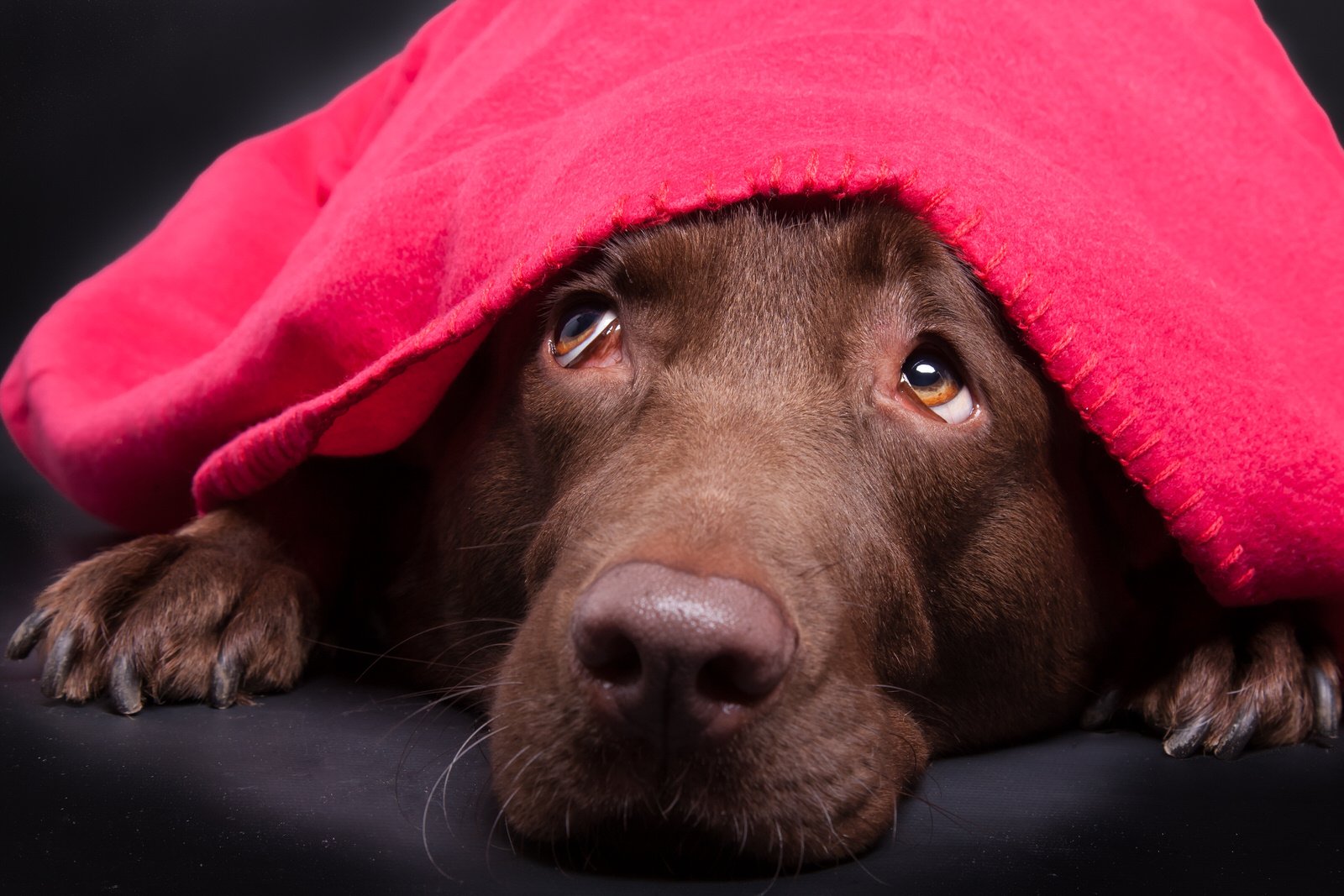
.
.
First, what is it about thunder and fireworks that scares dogs?
According to Dr. Marks, scientists are not completely sure on the true underlying cause of thunderstorm and firework phobia in dogs. Some experts believe that dogs are reacting to the lightning, some say they react to the noise, and others claim that dogs may sense changes in the air prior to the beginning of a storm.
From a training perspective, some people believe that these dogs may have had a lack of exposure to storms early in development, that a dog’s owner may have unintentionally reinforced a fear response (by acting a certain way every time a thunderstorm happens and inadvertently letting the dog know that acting fearful is the correct response to the storm), and/or that these dogs have a genetic predisposition to anxiety. So there may be several reasons why your dog is afraid of thunder or fireworks!
Is there anything that can make a dog more prone to fearing thunder, fireworks, and other loud noises?
As Dr. Marks stated above, we do not definitively know why some dogs can act completely comfortable as a train passes or when a loud clap of thunder occurs, yet other dogs are immediately startled, anxious, and fearful. However, Dr. Marks shared some helpful conclusions from a study published in the Journal of the American Animal Hospital Association (AAHA) in 2001:
- Herding dogs and hounds tend to be more thunder-phobic than other dog breeds.
- Rescued dogs have a higher incidence of thunderstorm phobias than the rest of the dog population.
While any dog can have this phobia, it is important to know if your dog might be more likely to develop it bases on their breed or history.
When will dogs start showing fear of loud noises, and what is happening physiologically in those fearful moments?
Most dogs who are sensitive to storms and other noises will start to display signs between 1 to 2 years of age according to Dr. Marks.
During an episode of noise phobia, these are some of the things that are happening inside your dog’s body:
- increased heart rate
- increased cortisol levels and blood sugar
- gastrointestinal upset
- increased breathing rate
- lick granulomas (nonhealing skin lesions due to chronic licking from anxiety)
None of these things are good for your dog, so it’s important to help them feel calm!
Now that we know some reasons why your dog might be fearful of thunder and fireworks and what happens to them when they’re fearful, let’s learn about how to help them feel more at ease!
What is recommended to help your noise-phobic dog feel better at home during thunderstorms and when fireworks are going off?
Safety and security are the key concerns for dogs with noise phobias. Not only can they run away from the home due to intense fear, they can easily injure themselves inside or outside of the home. So it is important that the methods you use are helping your pup feel safe first and foremost!
Dr. Marks provided several great strategies to help a dog with thunderstorm phobia be less anxious and fearful at home:
- Some dogs prefer to go into a “safe place” in the home like a bathroom or even in the bathtub itself because those surfaces significantly decrease the electricity in the air. If your dog prefers a space in the bathroom, in a crate, or in a closet or other enclosed space, let him be there as long as he is not hurting himself.
- Gentle massage and brushing can sometimes be helpful to reduce stress in your dog.
- Some owners find “natural” options like Rescue Remedy, valerian, melatonin, and Adaptil collars, sprays, and diffusers to be very helpful.
- There are a few “clothing” items that can be helpful: the Anxiety Wrap and Thundershirt are like dog “coats” that swaddle the dog and calm many of them. (It is similar to swaddling babies!) The Calming Cap is another calming clothing item—it covers the head and works like blinders on a horse.
- There are some dogs who seem to respond favorably to ambient noise or other comforting music during a thunderstorm. The theory behind this is that the positive sounds/music “drown” out the sound of the thunderstorm. The response in dogs is quite variable.
- If an owner has more time, systematic desensitization to the fearful noises can be very beneficial. This is the theory of very slowly exposing your dog to a trigger that causes fear and increasing the intensity with time as long as the dog stays relaxed. Dr. Marks gives this example: an owner can play sounds of thunderstorms on his or her smart phone at a very low volume and give simultaneous rewards if the dog is calm.
- There are anti-anxiety medications that can be discussed with your dog’s veterinarian that can be helpful as well.
Additionally, well before a storm begins, an owner can try to redirect a dog’s focus by teaching a trick or focused behavior (a mental task like sit or down) and rewarding with a high reward treat (like chicken or cheese) to hold his or her attention on something positive. Please note that this is not something that can be worked on after a dog is fearful or anxious, so do not try to start doing this during a storm!
If you know your dog is afraid of storms or fireworks, is it okay to leave them at home alone when one of those things is happening?
Dr. Marks said that many dog owners wonder if it is recommended to stay home with a noise-phobic dog during a thunderstorm or firework display. She says this decision really depends on the severity of the dog’s phobia in addition to the preparation the dog’s owner has done ahead of time to help relieve fear, anxiety, and stress and make the environment as safe as possible. Making sure the dog is in a safe space is just as important as knowing the severity of your dog’s fear, so do not skip that step if you need to leave home!
For a fireworks event, Dr. Marks has some specific advice for some things you can do to help keep your dog safe at home:
- Keep all windows closed
- Close curtains and turn ON lights to mask the flashes of fireworks
- Turn on a fan or air conditioner to mask the sounds of the fireworks
- Keep the dog INSIDE
If you are outside on a walk when fireworks or a thunderstorm begins, what should you do?
Dr. Marks let us know that there are a few dogs who actually feel better outside during these storms or fireworks events. If that is the case with an individual dog, the owner should make sure that the dog is in a very secure collar or harness, on leash, and equipped with ID tags.
If your dog is not one who can tolerate being outside during thunderstorms or firework displays, you should definitely still have them secure on their leash and harness and get them back inside as soon as possible.
Now that we know all about what happens when a dog is fearful of loud noises, when should you consult your vet about your dog’s fear?
Dr. Marks recommends consulting your veterinarian for advice if you notice any of the following signs in a dog during a thunderstorm:
- hiding under furniture or beds
- aggression
- drooling
- trembling
- sweaty paws
- pacing
- attempts to escape the house
- gnawing at window frames, door frames, curtains, or other household fixtures
- intense barking, whining, or howling
- inappropriate urination or defecation
Thunderstorm and firework phobia can be difficult for dogs at any time, but especially during the summer! Follow some of these tips from Dr. Marks, and you can help your dog feel better this season and all year long!
Thank you to Dr. Natalie Marks at Blum Animal Hospital for her insight into thunderstorm and firework phobia in dogs! We appreciate her hard work in making sure that every Chicago pet has the best life possible!
Blum Animal Hospital is located at 3219 N. Clark Street and has been caring for Chicago’s pets since 1952. They have been accredited by the American Animal Hospital Association (AAHA) since 1972. To learn more about Blum, their Fear Free certification and the calming techniques they use, check out their website!




